
views
Caring for Indoor Hibiscus Plants
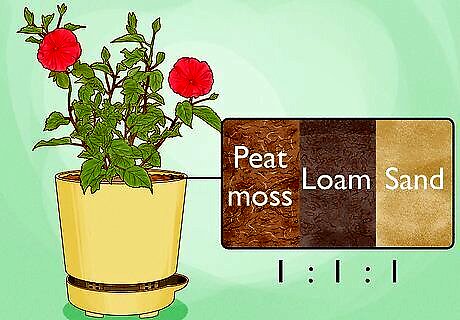
Grow potted hibiscus plants in loamy, lightweight soil. Hibiscus plants aren’t that particular about their soil mix, but they prefer lightweight material such as loam and peat moss. A regular bag of potting soil will usually work just fine. You can create their ideal soil conditions by mixing 1 part garden loam, 1 part peat moss, and 1 part fine sand or bark. A mix of 1 part coarse peat, 1 part composted bark, and 1 part composted manure mixed with a little bit of leca and vermiculite is also a great soil mix for hibiscuses.

Make sure the planter or container drains well. Loamy soil provides good drainage, but it's also important to grow hibiscuses in containers or planters that have plenty of drainage holes. After a watering, the environment should drain completely to prevent root rot. Water your plant, then watch for the water to come out of the drainage holes. Let the water drain into the plastic tray underneath. Give the roots time to soak up the excess water, but if water is still in the tray after 12 hours, dump it out.
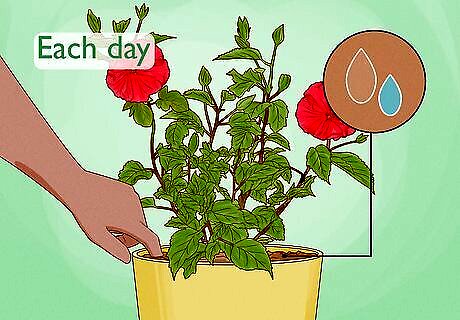
Keep the soil moist but never soggy. These plants need lots of water, especially during the warmest months when they’re blooming. Check the soil moisture each day by touching the top of the soil. If it feels dry, your plant needs to be watered. If it feels damp and slightly spongy, the soil is wet enough. Overwatering can cause root rot, so always touch the soil before watering.

Give your hibiscus plants warm water. Never use cold water on hibiscus plants. They like their water to be around 95°F (35°C). Use a thermometer or touch the water with your hand before administering it to check the temperature. Avoid using water that's much hotter than 95°F (35°C), since they don't like overly warm water either.
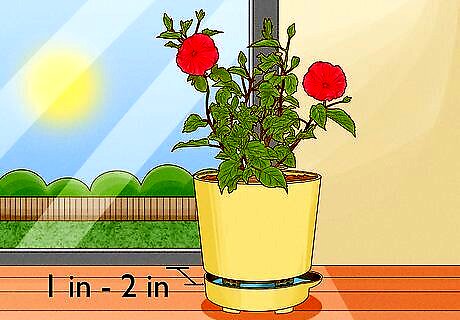
Put them where they can get several hours of direct sunlight daily. Hibiscuses will grow without direct sunlight, but they won’t bloom without at least 1 to 2 hours of direct sunlight every day. Place your hibiscus plants in a sunny window. Keep the plants 1 in (2.5 cm) to 2 in (5.1 cm) away from the window glass, since the hot glass can damage their foliage and blooms. With the proper amount of sunlight, hibiscus plants will bloom from spring until fall.
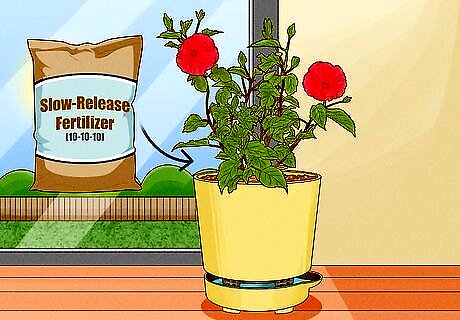
Fertilize them weekly during their growth period. Hibiscus plants flower from spring until fall, and weekly fertilizing will result in more abundant blooms. Apply a slow-release fertilizer (like 20-20-20 or 10-10-10) or a specially formulated hibiscus fertilizer around the base of the plant. Look for a fertilizer with trace elements like iron and magnesium, which support growth and blooming. You can also mix up a weak solution of water-soluble fertilizer (half strength or less) and dose your plants with a little fertilizer each time you water them. Avoid over-fertilizing since too much phosphorus can kill hibiscus plants.
Growing Hibiscus Plants Outdoors
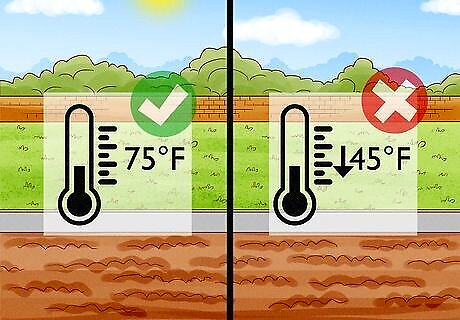
Plant hibiscuses after all danger of frost has passed. 75°F (24°C) is the ideal blooming temperature for hibiscus plants, although they can withstand warmer and cooler temperatures. There should be no danger of frost after planting your hibiscuses. If the temperature falls below 45°F (7°C), the plants may not recover. Hibiscuses cannot survive frost or freezing temperatures.
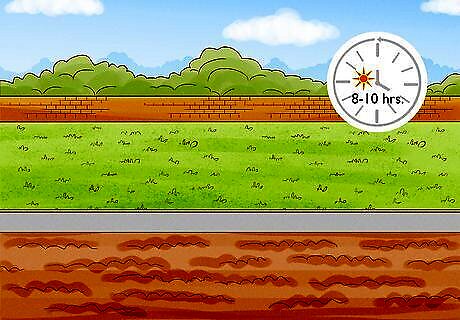
Plant hibiscuses in an area that gets full sunlight. You can plant hibiscuses outside in spring, summer, or fall in temperate climates. They are tropical plants, so they prefer humidity, warm temperatures, and 8 to 10 hours of direct sunlight each day. The plants will still grow in partial shade, but they will be less healthy and bloom far less frequently in this environment.

Make sure the soil drains well before planting hibiscus plants. Hibiscuses need well-draining soil to thrive, and poor-draining soil will cause root rot. To test your soil's drainage, dig a hole that’s about 12 in (30 cm) wide and 12 in (30 cm) deep. Fill the hole with water. If the water drains in 10 minutes or less, your soil drains well. If it takes an hour or more to drain, the drainage is poor. To improve drainage, mix in organic matter like well-rotted manure, compost, or peat moss. If the soil drains well, you don’t need to add anything else to it.
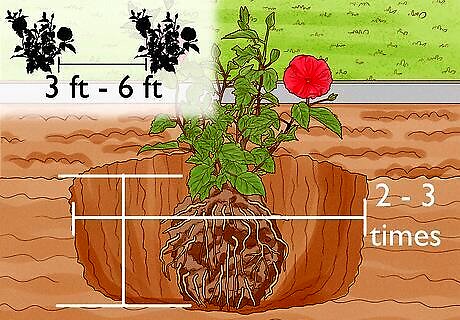
Dig a hole that is about the same depth as the root ball. Check the size of the plant's root ball, then dig a hole that's about the same depth. Make the hole at least 2 or 3 times wider than the root ball. Gently remove the plant from its container and place it in the hole. Add soil around the plant until the hole is half-filled. Water the hole well, let it drain, and then fill the rest of the hole with soil. Water the plants thoroughly after putting them in the ground. Plant hibiscuses 3 ft (91 cm) to 6 ft (180 cm) apart.
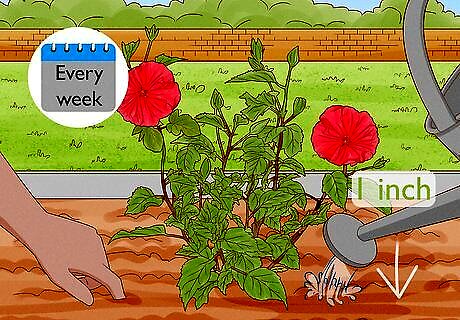
Water the plants 3 to 4 times per week with warm water. Hibiscus plants need plenty of water and like their soil to be consistently moist, but never soggy. You can check the soil’s moisture by touching it. If it feels dry and crusty, your plants need to be watered. If the soil feels soft and damp to the touch, you don’t need to water your plants that day. Touch the water before pouring it on the plants. They don’t like cold water, so use water that feels warm but never hot to the touch. Hibiscuses need a minimum of 1 in (2.5 cm) of water every week. These plants prefer rainwater, but will do fine with city water.
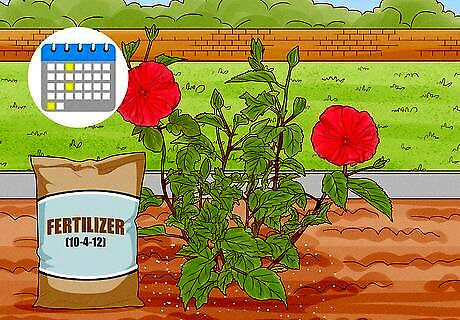
Fertilize your hibiscuses every 2 weeks during the blooming period. Use a water-soluble or liquid fertilizer for best results. A balanced 10-10-10 fertilizer will work just fine. Choose an organic variety that contains trace elements like potassium, iron, and magnesium. Apply the fertilizer at the base of each plant every 2 weeks. Don’t use chemical fertilizers on hibiscus plants. If you can find a fertilizer with a very low amount of phosphorus in it, like a 10-4-12 or 9-3-13, go with that. Avoid over-fertilizing since too much phosphorus can kill the plants.
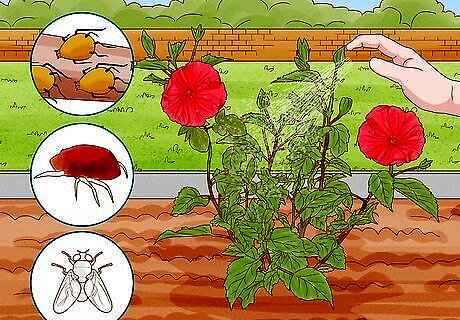
Check the plants weekly for aphids, whiteflies, and spider mites. These particular pests can be a problem for outdoor hibiscus plants. Check your plants weekly for signs of infestation. If you discover an infestation, apply a horticultural oil or insecticidal soap to the affected areas to get rid of the problem. Avoid insecticides that contain the ingredient imidacloprid since this ingredient can worsen spider mite infestations.
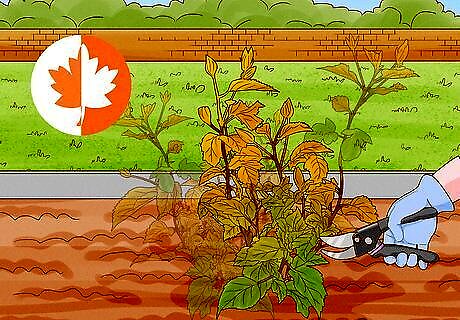
Prune your hibiscus plants in the fall. Pruning will keep your plants looking healthy and stimulate blooms. Prune once per season, in the fall, although pruning can be done successfully in the spring if necessary. Keep 3 to 4 sturdy main branches on each plant. Cut away about a third of the remaining branches. Remove all weak growth and any branches that are growing sideways.




















Comments
0 comment